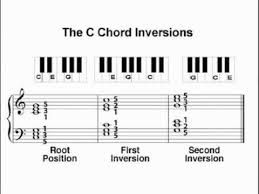The chords are based on scale degrees. If you look at the C Major scale you get: C D E F G A B C
The major chord takes the root, the major third, and the fifth, or the 1st, 3rd, and 5th notes from the above scale: C E G
Once you have the chord, you can
make inversions. This is helpful to
change the sound of it slightly,
putting different notes in the bass,
and helpful on guitar where playing 1-3-5 isn't as easy with certain fingerings.
So the G-C-E chord you mentioned, is the same notes as C Major C-E-G, in a different order, or 5-1-3 which is the second inversion. The first inversion is 3-5-1 or E-G-C.
Edit: For comparison's sake, you
might think at first glance that G-C-E is a G chord, but in G Major, C is the 4th and E is the 6th, so that would be 1-4-6 chord which isn't the major chord. G Major (1-3-5) is G-B-D.

#pianolessons #chords #scales #piano #chordprogression #inversions #tutorial #music
What is so true good job
Downvoting a post can decrease pending rewards and make it less visible. Common reasons:
Submit
Thanks !
Downvoting a post can decrease pending rewards and make it less visible. Common reasons:
Submit